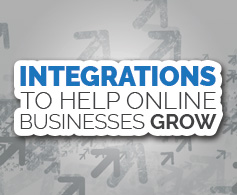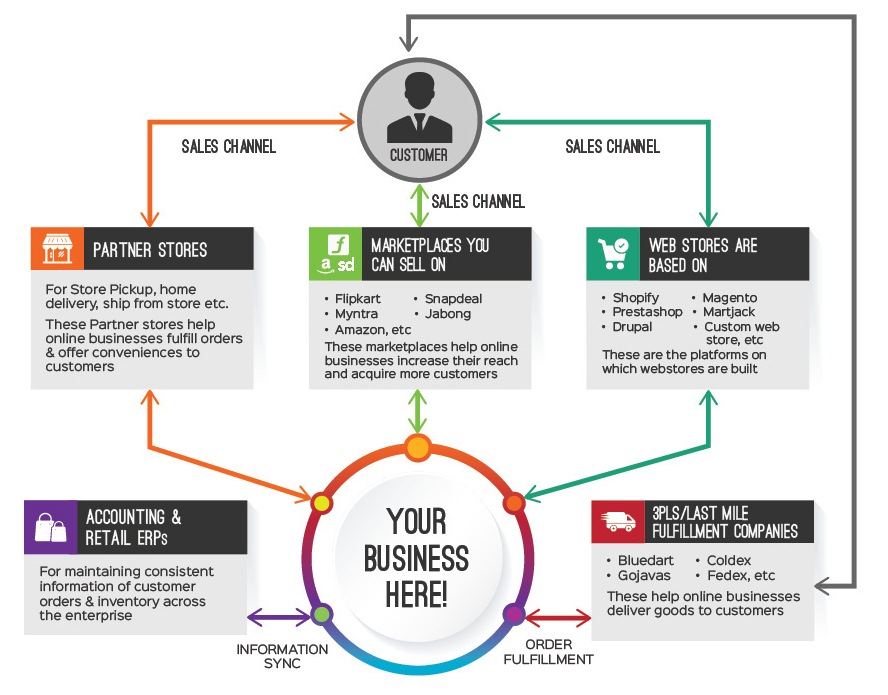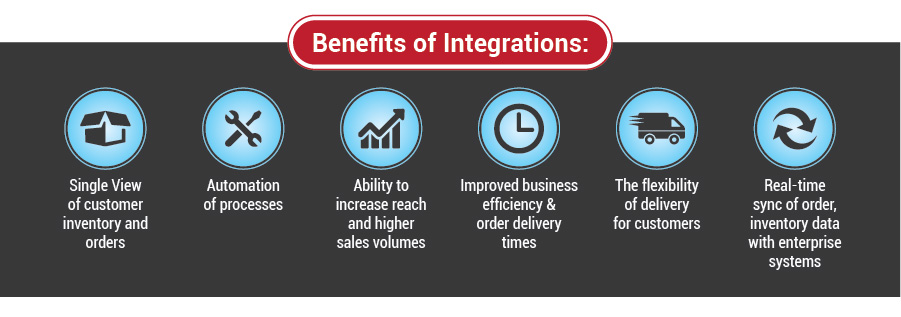Selling Online On Your Own Store– Dos and Don’ts for Online sellers
Sell Online 101 : What should I know about selling online?
Selling online can seem intimidating, especially so if you have no guide to prepare you for the challenges that lie ahead.
Want to get started, but don’t know how? Read our post to start selling in these 3 simple steps.
In our series, we’ve covered how Lisa managed to not only sell on her own web store, but also on multiple marketplaces.
Lisa’s story –
Lisa has a business selling women’s clothing. Year on year, her business grew to become profitable.
After a while, her sales stopped growing. She wanted to grow her profits, scale up her business, and reach more customers. She decided that the best thing she could do was sell online.
Since then, she has grown her business reach – and the profits have grown with it. This is a list of some common dos and don’ts for newbie sellers, selling on online stores:
DOs:
- Know your market – Identify your customers, the hottest products, and understand what you want to sell. Most successful sellers sell a focused range of products that they can brand as their own – and build a marketing strategy around.
- Choose the right eCommerce platform – Make sure you use the right eCommerce platform, one that suits your business goals and budgets. Quite a few businesses start off with simple, off the shelf options like Shopify or Read our complete guide to choosing an eCommerce platform here.
- Build your brand – Your store is an extension of your products – a customer who trusts your brand/store identity, is more likely to buy from you. Be upfront about the items you are offering, and craft a distinctive brand image around your offerings. Your store should attract new customers, as well as retain old ones. Include the following sections on your website to ensure that customers stay:
- About Us – It gives your customers an insight into your business, and can be one of the many ways you can attract customers to your site.
- Shipping and Delivery – Clear and detailed information about the shipping/delivery charges and times should be present on your website so that the customers can make a fact driven purchase decision.
Policy –Highlight the policies regarding your returns, etc. clearly. Establish site-wide policies that apply to all of your merchandise. Display the policy prominently. - Contact Us – Current and relevant information is vital to ensuring that leads come your way. If a customer wants to get in touch with you, this can be one of the fastest ways of ensuring that connection.
- Follow Us On – You can leverage your website to increase your reach and engagement with customers
Once you have your own unique brand identity, you can promote it via social media platforms, and offers/discount offered to customers via emails.
- Provide a fantastic browsing/ shopping experience – Your customers are everywhere – tablets, mobile, and laptop, desktop. Make sure that you are too! Provide your customers with a seamless shopping experience across channels and one that is consistent with your brand identity. All your touch points with the customers should deliver a smooth browsing experience for your customers.
- Automate Your Processes: In the long term, you cannot excel with excel! As a first initiative put in an order management software that manages your orders, inventory and returns seamlessly across your sales channels to facilitate the smooth shopping experience your customers.
- Give them excellent post-sale experience – Customer support is one of the important areas a lot of online retailers don’t give enough attention to. After you make the sale, make sure that your customers can reach out to you for any issues they have, via a responsive customer support service.
DON’Ts:
- Be focused on what you are selling – In a competitive market, more often than not, you will find specialized stores do better than a general store. Before you begin selling, it is important to decide which of the two you want to adopt as your business strategy. Marketing your products in a competitive space can be more difficult than marketing them in a niche market space.
- Forget to capture customer data – Gather information about the customers who are visiting your site – their browsing habits, their favored products, etc. This data can help you personalize your web store, by tailoring it to customers’ needs.
- Sell low-quality products – Word of Mouth can either make or break you – Selling low-quality merchandise turns off buyers faster than anything else, and they don’t waste any time telling other potential customers about their bad experiences.
These tips worked for Lisa – did they work for you? Let us know in the comments below.
Looking to sell online? With ready integrations to global marketplaces, front-ends, and leading last-mile fulfillment companies, Vin eRetail eXpress helps you sell across marketplaces, manage orders across multiple channels & fulfill with ease.Request a demo today.


Selling on Marketplaces – Dos and Don’ts for Online sellers
Sell Online 101 : What should I know about selling online?
Selling online can seem intimidating, especially so if you have no guide to prepare you for the challenges that lie ahead.
Want to get started, but don’t know how? Read our post to start selling in these 3 simple steps.
In our series, we’ve covered how Lisa managed to not only sell on her own web store, but also on multiple marketplaces.
Lisa’s story –
Lisa has a business selling women’s clothing. Year on year, her business grew to become profitable.
After a while, her sales stopped growing. She wanted to grow her profits, scale up her business, and reach more customers. She decided that the best thing she could do was sell online.
Since then, she has grown her business reach – and the profits have grown with it. Amazon, Flipkart, AskmeBazaar, eBay, Lazada, Snapdeal – she is selling on multiple marketplaces with ease.
Initially, it can get difficult to understand which marketplace to sell on. Read here to decide for yourself.
This is a list of some common dos and don’ts for newbie sellers:
DOs:
- Develop a strategy – Before you begin online selling, it is important to have a marketing strategy in place for all the products you intend to place on your catalogs. In marketplaces, it is important to have a unique, different brand identity so as to stand out among the clutter.
- Search words, Search words – If you are not discoverable, you will not sell! Leverage search words relevant to your listings to make yourself and your brand more accessible to potential customers.
- Choose an order management software to sell easily – Selling on a single marketplace? Two? Multiple? Selling on marketplaces can get tedious – updating inventory, handling dispatches, etc. on many marketplaces at the same time. A better option would be to go for software that manages all this for you – across all the marketplaces that you want to sell on.
- Provide accurate product information – Would you want to lose customers over fuzzy product information? Your products are your identity – and the first touchpoint with your customers. Buyers want to know what they are buying – before they make the purchase.
- Images – Ensure that your images are clear, and representative of the actual product you are selling. The picture should be easy to see and the item you’re selling should be the focal point. Zoom in as much as possible to highlight the item. Take photos from different angles.
- Product Descriptions – To avoid losing customers, ensure your product description is accurate, clear and concise. For example, far too often, vague words like ‘awesome’ and ‘cute’ lead to confusion among your customers.
- Packaging and shipping – Will you package and ship your orders yourself? Or would you like to get that done by the marketplace? For instance, if you sell on Amazon, you have the option to get your orders fulfilled by Amazon. Choose the option that offers the most value to your business.
DONT’s:
- Disregard feedback – Most marketplaces allow customers to give feedback and ratings. Take the feedback seriously – parameters for seller performance include cancellation orders, customer returns, complaints about quality, etc. Low ratings could affect your reputation in the marketplace – which in turn affects your sales.
- Try to sell too many products. Be focused on what you are selling – In a competitive market, more often than not, you will find sellers selling niche products do better. Marketing your products in a competitive space can be more difficult than marketing them in a niche market space. If you have a strategy in place, stick to it. Don’t try to sell too many products under your brand all at once, while starting out.
These tips worked for Lisa – did they work for you? Let us know in the comments below.
Looking to sell online? With ready integrations to global marketplaces, front-ends, and leading last-mile fulfillment companies, Vin eRetail eXpress helps you sell across marketplaces, manage orders across multiple channels & fulfill with ease.Request a demo today.
How eCommerce Integrations can help you grow your Online Business.
An eCommerce integration is how an online business interacts with its online sales channels (e.g. web stores, marketplaces, etc.), backend operations (order management, inventory management, etc.), and shipping/delivery providers.
If you’re selling online, you need to scale up your business. For any online business to grow in scale, it needs integrations to sales channels like its own website and marketplaces to increase reach and offer more conveniences to customers. A business would also need to keep its data consistent across enterprise systems and deliver to customers via shipping partners.
For any online business, there are 3 components –
- Web interface – This is how the business interacts with the customers. Your own website such as myshop.com is your own personal store. These web stores are built on SaaS-based platforms such as Shopify, PrestaShop, MartJack, Drupal, etc. Businesses may also sell on multiple marketplaces.
Backend– A business manages its day-to-day operations via its backend. This includes managing orders, creating a single inventory pool to assign and fulfill orders correctly for timely, efficient delivery. - Delivery – The ability to fulfill online orders and manage returns through shipping and fulfillment companies. Here the ability of a business to quickly process orders and deliver them to customers in the shortest possible time is crucial.
As businesses grow, complexities owing to scale and size increase. Here, these integrations are crucial to helping the business scale up and manage vendors.
Types of integrations:
- Integration to Web-fronts: Web-fronts are SaaS-based solutions on which u can build your web stores.
- Integration to Marketplaces: Businesses may want to list on multiple marketplaces both domestically and globally to be able to acquire more customers and increase their sales.
- Integrations to Shipping companies/Fulfillment companies: To be able to effectively deliver goods, a system needs to leverage the services of these companies.
- Integrations to Retail and Accounting systems: To make sure all their data is in sync across the enterprise, organizations need to be integrated these ERP and retail systems.
Vin eRetail is a SaaS-based retail suite for multi-channel retailing. With ready integrations to leading marketplaces, third party logistics companies , financial and retail systems it makes it easy for Sellers on Marketplaces, eTailers, Marketplaces, 3PLs, CPG, and Brick n Mortar Retailers to sell and manage the order management and fulfillment processes easily.
Check out the complete list of integrations here.
Any tips or comments for us? Leave them in the section below.
Read More





